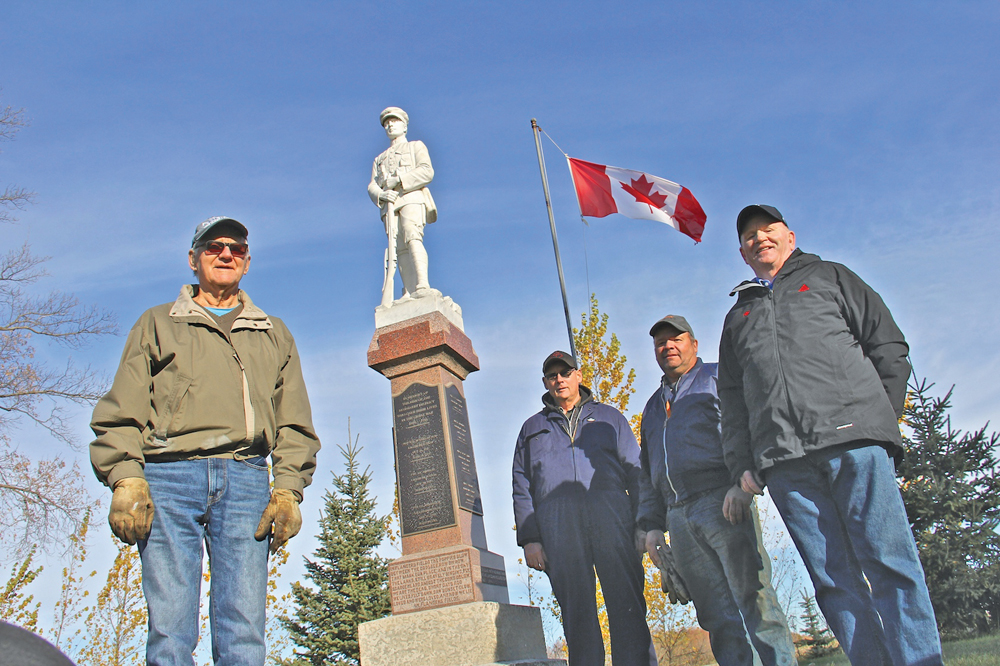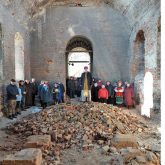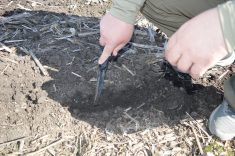Pale November sunlight glints off the cold red granite where their names are inscribed.
They were farm boys, seven sons of Margaret families, who never returned home to their small southwestern Manitoba village a century ago.
Sgt. William David McKellar’s name is on this monument. He died in a sea of blood-soaked mud October 26, 1917, only 26, while fighting with the 1st Canadian Mounted Rifles in the Battle of Passchendaele.
Just four days later, another young man from Margaret would fall on the same battlefield; he was Pte. John Kennedy Murray, with the 78th Battalion (Winnipeg Grenadiers). He’d just turned 20.
Read Also

Province pledges funds to CentrePort Canada
The Manitoba government has pledged $450,000 towards projects at inland port CentrePort Canada.
Neither man’s body was ever found and neither has a known grave. They fell on days hundreds of men in the Canada Corps also lost their lives: 569 died October 26, 850 more on October 30.
This small farm town would grieve more losses the following year; the names, ages and dates of the deaths of Pte. E. Stephens and Pte. S.W. Garbutt, Pte. G.V. Lancaster, Pte. G. Wilkins and Pte. J.G. Campbell are also on that monument.
June 1921
Local historical records describe a day in June of 1921, when a large crowd gathered in the pouring rain here. Among them were these dead men’s grieving families, and hundreds more. They’d gathered in Margaret to honour these fallen men and to see their village’s new war memorial, a life-size pure white effigy of a Canadian soldier, unveiled.
It had been made by a marble dealer (E.J. Skelton) in Walkerton, Ont., according to the local history book. It was brought here by William Campbell who, it also says, went to Ontario and personally ordered the monument. One can only imagine the grief the man carried as he took on the solemn task: the marble soldier would bear a striking resemblance to his son, James Gilbert Campbell.
A news account of his service with the 100th Battalion Winnipeg Grenadiers says he died in February 25, 1918. He was just 19. He is buried in France.
Margaret Memorial Park
Derek Jackson, Margaret-area resident has kept an aerial photo of Margaret taken for the Manitoba Pool Elevator calendar in 1992. It’s an image of a treed, neatly kept village below in August, surrounded by swirls of swathed wheat fields, with a clear view of the soldier standing in a special park encircled by a bed of red petunias.
Eighty years since that day in 1921 the park was neatly mowed, its hedges, trees and flowers attentively cared for.
“You can see how immaculate the grounds were kept,” says Jackson.
The well-tended park was the pride of Margaret even then. By the 1990s the numbers of those living here had dwindled well below 100 who had once made this village their home. Now residents tend to say “about 10” when asked about their numbers.
Who continued to looking after the stone soldier all these years? It was a question Canadian author Alan MacLeod asked on a day visiting Margaret in 2011 to photograph and document the site for a book he was writing Remembered in Bronze and Stone: Canada’s Great War Memorial Statuary. The book was about one specific type of war memorial chosen by communities across the country, that of a bronze or stone sculptures of a solitary Canadian soldier.
Notably it was communities in Manitoba, Ontario and Nova Scotia that most often chose this particular type of war memorial to remember their fall, says MacLeod, who eventually counted 33 such monuments found here and documented 18 out of the 25 he visited in his book.
The Margaret monument was in such excellent condition he would remark on it several times in his book.
“The Margaret marble is perfectly white and clean. The observer has no need to squint his eye through a crust of lichen and grime,” he wrote. “A flagpole stands beside the monument, a fresh Canadian red maple leaf fluttering from its top…”

Memorial services
Margaret’s remaining residents can remember the memorial services that were held here every year after 1921. Orchestras would play. Dignitaries would speak. The stone soldier’s park would be lined with wooden chairs and benches.
“They’d have guest speakers,” recalls Ross McMillan, 89, a retired local farmer. “What I remember most is how people came from different communities. It wasn’t just a local gathering in my recollection.”
Those services ceased during the 1980s, but, as was evident to MacLeod nearly three decades later, not the attentive care Margaret residents continued to give the war memorial site.
That pure white stone was the result of special efforts made in the 1970s to keep the monument in perfect condition.
Riverside Heritage, the area history book, also notes how, in 1974, the Campbell family would again honour their family member. That year Glen Campbell “brother of Gilbert” had the monument professionally cleaned and restored, it says.
It also gives clues as to the site’s seemingly invisible gardeners. “Outside of 21 years of paid caretaking (1937-58),” it also says, “the community has taken pride in tending this lovely park… the names are far too numerous to mention…”
It mentions one, however. He was Howard “Spike” Tibbatts, who, it says took great pleasure and pride maintaining it for many years until his death in 1994. Tibbatts was a buyer for United Grain Growers and remembered for seldom being without a pair of pruning sheers in hand, as he went about town, keeping not just the memorial park’s hedges and trees trimmed and pruned, but pretty well every tree in Margaret. He’d see to it that even trees on yards of emptied homes in Margaret were looked after, says Jackson.
“Spike claimed every tree in Margaret that no one else was looking after,” he said.
Looking ahead
More recently, Margaret did something else to ensure the long-term care of its war memorial.
Realizing Margaret’s days were numbered, as population thinned, the remaining residents here began to plan for the future. In 1988 a perpetual care plan, with an associated fund for donations, was established to ensure the community’s cemetery — where headstones by then far outnumbered living residents — would always be maintained. At the same time, they began to plan for the long-term care of the stone soldier too.
Margaret residents widely credit a now-deceased citizen, Howard Nixon, for advocating that the monument be moved to the cemetery to be part of its perpetual care plan. People recall him expressing concern there would be no one left in Margaret to care for the site.
“He (Howard Nixon) said, ‘we’re going to run out of people eventually,’” recalls Jackson, who can vividly recall the day the statue was moved to its present-day location — October 5, 2004.
Community drawn together
Today it is a small group of local farmers, most sons of Second World War servicemen who survived and returned home to Margaret, who now tend the cemetery grounds where the soldier monument stands.
They are not alone among those pledged to maintain this site into the far future. Fewer than ever now live here, but many more have family ties to Margaret, says McMillan who is also chair of the local cemetery board. Their loved ones are buried in the local cemetery.
“There aren’t many left right in the community but when we called a meeting (of the cemetery committee) in June we had 15 people there,” he said. “They came from Brandon, Winnipeg, Souris, Boissevain, Minto. They don’t necessarily live in the district anymore but they’re still interested in maintaining it.”
That cemetery board will continue to care for that monument and takes pride in its condition, says another Margaret-area farmer.
“It is in such good shape,” said Chris Monk. “We certainly hope to keep it that way.”

Vigilance
MacLeod’s book features 130 of some 200 of these statues found across the country and he reflects extensively on the condition of the monuments he’s seen.
“White stone soldiers need to be looked after,” he writes in his book. He describes many more sites also well cared for. Others, he says, have already become a “much eroded remnant” of what was placed so many years ago.
“Some communities attend vigilantly to the duty; others do not,” he said.
Twenty of the 27 men who enlisted from Margaret to serve during 1914 to 1918 would eventually return home. Between 1939 and 1945 another 37 of the 38 who served their country those years would.
The war memorial would have just one more name added due to that war. He was A.A. (Alvin) Patton, who’d have been just a little boy during the First World War. Patton enlisted and served, dying at the age of 29 on March 31, 1944.
“I was very impressed with what I saw at Margaret,” MacLeod wrote in a recent email, describing how the condition of the monument here is all that much more touching given there’s no sign of who continues to remember and to care.
In Remembered in Bronze and Stone he wrote:
“Who is to be credited for the excellent state of the white-stone soldier of Margaret? Nothing on the site offers an answer. Perhaps it is enough to rejoice that someone in a hamlet now largely vanished cares enough to meet a duty that almost all the people of Margaret would have faithfully embraced in the years following the Great War.”
Special thanks to Alan MacLeod for contributing his time researching this article.
















